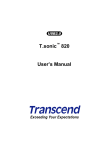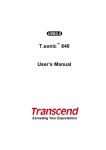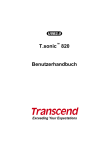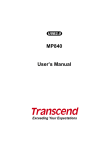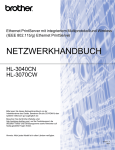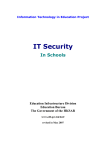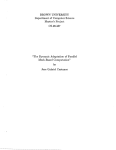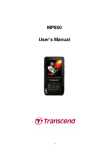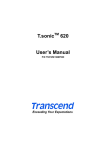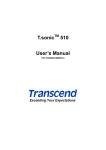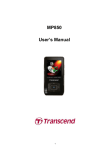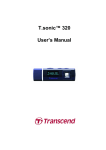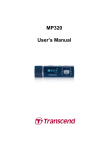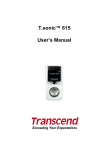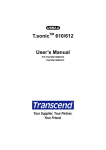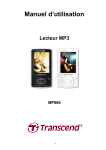Download Transcend Information Transcend T.sonic 630 User's Manual
Transcript
™ T.sonic 630 User’s Manual Table of Contents Introduction ............................................................................................................................1 Package Contents..............................................................................................................................1 Features.............................................................................................................................................2 System Requirements........................................................................................................................3 Safety Precautions .................................................................................................................4 General Use.......................................................................................................................................4 Backing Up Data ................................................................................................................................4 Caution: Risk of Deafness .................................................................................................................4 Reminders..........................................................................................................................................4 Product Overview ...................................................................................................................5 A-B Repeat/Rec Button......................................................................................................................5 Menu Button.......................................................................................................................................5 LOCK Switch......................................................................................................................................5 Hi-Speed Mini USB 2.0 Port ..............................................................................................................5 Back-Fast Rewind Button ..................................................................................................................5 Next-Fast Forward Button..................................................................................................................5 PLAY/PAUSE/PWR ON-OFF Button .................................................................................................5 Volume Up Button..............................................................................................................................5 Volume Down Button .........................................................................................................................5 Line-In Port ........................................................................................................................................5 White Text OLED Display ..................................................................................................................5 Microphone ........................................................................................................................................5 Earphones Jack .................................................................................................................................5 Neck Strap hole .................................................................................................................................5 OLED Display..........................................................................................................................6 Basic Operation......................................................................................................................7 Charging the Battery ..........................................................................................................................7 Power ON ..........................................................................................................................................7 Power OFF.........................................................................................................................................8 Play a Track .......................................................................................................................................8 Pause a Track....................................................................................................................................8 Next Track..........................................................................................................................................8 Previous Track ...................................................................................................................................8 Fast Forward......................................................................................................................................8 Fast Rewind .......................................................................................................................................8 Increase Volume ................................................................................................................................8 Decrease Volume ..............................................................................................................................8 Main Menu .........................................................................................................................................8 Make an Audio Recording..................................................................................................................9 Repeat a Track ..................................................................................................................................9 Repeat All Tracks...............................................................................................................................9 Shuffle: Play Random Tracks ............................................................................................................9 Repeat All Tracks in a Folder.............................................................................................................9 A-B Repeat: Repeat a Section of a Track..........................................................................................9 Lock ...................................................................................................................................................9 Reset the T.sonic™ 630......................................................................................................................9 MUSIC Mode .........................................................................................................................10 Play MP3, WMA and WMA-DRM10 (Subscription) Music ...............................................................10 File Navigator Mode.........................................................................................................................10 Delete a file in the MUSIC Mode......................................................................................................11 RADIO Mode .........................................................................................................................12 Listen to the Radio ...........................................................................................................................12 Selecting a Radio Station.................................................................................................................12 Increase/Decrease the Volume........................................................................................................12 Saving a Radio Station ....................................................................................................................12 Recall a Saved Station.....................................................................................................................14 Record a Radio Station....................................................................................................................14 RECORD Mode .....................................................................................................................14 Record Sound ..................................................................................................................................15 Select a Recording Device...............................................................................................................15 Record using the Built-In Microphone..............................................................................................16 Record using the External Microphone............................................................................................16 Record using the Line-In connection ...............................................................................................17 Play a Recorded Sound File ............................................................................................................18 File Navigator Mode.........................................................................................................................18 Delete a file in the RECORD Mode..................................................................................................19 Settings .................................................................................................................................20 Enter the Settings Menu ..................................................................................................................20 Repeat Mode ...................................................................................................................................20 Equalizer (EQ) Mode .......................................................................................................................20 User EQ Customization ...................................................................................................................22 Screen Saver ...................................................................................................................................22 Sleep................................................................................................................................................24 Contrast ...........................................................................................................................................24 Language .........................................................................................................................................24 Sync Lyrics.......................................................................................................................................25 Playback Speed ...............................................................................................................................25 FM Reset .........................................................................................................................................25 Music Transfer Mode .......................................................................................................................26 Playlist Manager ..............................................................................................................................26 About................................................................................................................................................27 Time Settings........................................................................................................................28 Real Time Clock (RTC)....................................................................................................................28 World Time.......................................................................................................................................29 Daylight Saving Time (DST) ............................................................................................................30 Advanced RECORD Settings...............................................................................................31 REC Quality .....................................................................................................................................31 REC Environment ............................................................................................................................33 REC Input Device ............................................................................................................................33 VAD (Voice Activation Detection) ....................................................................................................35 Preset REC ......................................................................................................................................35 Driver Installation .................................................................................................................37 Driver Installation for Windows® Me, 2000 and XP..........................................................................37 Driver Installation for Mac™ OS 10.0, or Later .................................................................................37 Driver Installation for Linux™ Kernel 2.4, or Later ............................................................................37 Connecting to a Computer ..................................................................................................38 Download and Upload Music and other Files ....................................................................39 Disconnecting from a Computer .........................................................................................41 Removing the T.sonic™ 630 in Windows® Me, 2000 and XP ...........................................................41 Removing the T.sonic™ 630 in Mac™ OS 10.0, or Later ...................................................................41 Remove the T.sonic™ 630 in Linux™ Kernel 2.4, or Later.................................................................41 T.sonic™ Utility Software .....................................................................................................42 Installing the T.sonic Utility Program................................................................................................42 Using the T.sonic Utility Program.....................................................................................................44 PC-Lock Function.................................................................................................................45 PC-Lock Function for Windows® Me, 2000 and XP .........................................................................45 Lock Your Computer ........................................................................................................................47 Unlock Your Computer.....................................................................................................................47 Boot-Up Function .................................................................................................................48 System Requirements for the Boot-Up Function .............................................................................48 Enabling the Boot-Up Function ........................................................................................................48 Partition & Security Function ..............................................................................................50 Enable the Security Function in Windows® Me, 2000 and XP..........................................................50 Use the T.sonic™ Security Features.................................................................................................51 Changing your Password.................................................................................................................51 Forgotten your Password.................................................................................................................52 Restoring Factory Defaults..................................................................................................53 Recover the T.sonic™ 630 in Windows® Me, 2000 and XP ..............................................................53 Troubleshooting ...................................................................................................................54 Specifications .......................................................................................................................57 Ordering Information............................................................................................................57 Transcend Limited Warranty ...............................................................................................58 Glossary Icons......................................................................................................................59 Terminology..........................................................................................................................61 Thank you for purchasing Transcend’s T.sonic™ 630. A new generation of Flash MP3 Player that combines all the advantages of a great sounding MP3 player with a USB Flash Drive and includes many extra features as standard such as, an FM Radio, Advanced Digital Voice Recorder, Direct Line-In recording, Karaoke-type Lyrics display, A-B repeat functions and variable Track Playback speeds. Your T.sonic™ 630 supports Hi-speed USB 2.0 for faster uploading and downloading of data, or music files to and from a computer. Using the A-B repeat and variable Track Playback speed features allows you to continuously replay a designated section of a track at slower/faster speeds; this makes the T.sonic™ 630 an ideal language-learning tool. In addition, you can record memos to yourself or from others using the advanced digital voice recorder and the unit’s Line-In recording feature lets you record music, or audio books directly from a CD Player, or external microphone to your T.sonic™ 630. The stylish T.sonic™ 630 from Transcend will change the way you think about your digital music forever. Package Contents The T.sonic™ 630 package includes the following items: z T.sonic™ 630 z Earphones z Software CD z Mini USB to USB A-Type cable z Direct Line-In Recording cable 1 Introduction Introduction Introduction z Quick Instruction Guide Features z MP3 Player that supports MP3, WMA, WMA-DRM10 (subscription music) and WAV music formats z FM Radio (FM Radio recording and the ability to preset 20 FM radio stations) z Advanced Digital Voice Recorder: specify an individual (memo), or group (meeting) environment z One-Touch Recording: even when Powered OFF, press and hold the REC button to start the Built-in Microphone Recording z Karaoke-type lyrics display z Direct Line-In recording from a CD Player, or external Microphone z Brilliant, White text (4-Line) OLED Display produces a vibrant clear display, easily viewed at any angle and in any light z Scheduled Recordings: preset a time to auto-start a Radio, or Microphone recording z VAD (Voice Activation Detection), Very High quality Gapless Audio Recordings z Playlist Builder z A-B repeat function allows you to continuously replay a designated section of a track z Variable Track Playback speeds z Supports 12 user languages including song/artist name display z USB Flash Drive capabilities for data transfer and storage, plus additional software z 7 Equalizer effects, including a customizable USER EQ setting z Powered using a rechargeable Li-ion battery (fully charged battery supports over 15 hours of continuous operation) z Hi-Speed Mini USB 2.0 port for easy computer connectivity and fast file transfers z Sleep Mode, preset the player to Auto-Power OFF after 15, 30, or 60 minutes z Automatic screen saver runs if the unit is idle for more than a few seconds, this acts as a battery saving measure z Real Time Clock (RTC) displays local and world times 2 Desktop or notebook computer with a working USB port. One of following Operating Systems (OS): z Windows® Me z Windows® 2000 z Windows® XP z Mac™ OS 10.0, or later z Linux™ Kernel 2.4, or later 3 Introduction System Requirements Safety Precautions Your T.sonic™ 630 is connected to a computer using a Mini USB to USB A-Type cable. Please ensure that you connect the cable ends to the ports correctly. General Use z Carefully unpack the contents of the T.sonic™ package. z Do not allow your T.sonic™ to become damp or wet from water or any other liquids. z Do not use a damp/wet cloth to wipe or clean the exterior case. z Do not use or store your T.sonic™ in any of the listed environments: o Direct sunlight o Next to an air conditioner, electric heater or other heat sources o In a closed car that is in direct sunlight Backing Up Data z Transcend does NOT take any responsibility for data loss, or damage during operation. If you decide to store data on your T.sonic™ we strongly advise that you regularly backup the data to a computer, or other storage medium. z To ensure Hi-Speed USB 2.0 data transfer rates when using the T.sonic™ 630, please check the computer has the relevant USB drivers installed. If you are unsure on how to check this, please consult the computer, or motherboard User’s Manual for USB driver information. Caution: Risk of Deafness 1. Repeated or regular use of headphones or earphones at volume levels above 80 decibels can give a false impression that the audio level is not high enough. Users may try to progressively increase the volume control therefore risking a dangerous noise level for their ears. 2. To protect your health and your hearing, keep the volume of your MP3 player below 80 decibels and do not use for an extended period of time. Stop use if symptoms like headaches, nausea, or hearing disorders occur. 3. Your MP3 player is limited to a volume level of 100 decibels. 4. Both the MP3 player and its accompanying earphones are compliant with the French regulation concerning musical Walkmans (24th July 1998 Order). 5. Before using other earphones, confirm that their technical specifications are compatible with the original set. Reminders 1. Make sure the LOCK switch is set to “OFF” before trying to Power ON the unit. 2. Never use the “Quick Format,” or “Full Format” in Windows® to format your T.sonic™ 630. 3. Follow the procedures in the “Disconnecting from a Computer” section to remove your T.sonic™ 630 from a computer. 4 Safety These usage and safety guidelines are IMPORTANT! Please follow them carefully. Player Controls Product Overview Figure 1. T.sonic 630 A Reset Switch B A-B Repeat/Rec Button C Menu Button D LOCK Switch E Hi-Speed Mini USB 2.0 Port F Back-Fast Rewind Button G Next-Fast Forward Button H PLAY/PAUSE/PWR ON-OFF I Volume Up Button J Volume Down Button K Line-In Port L White Text OLED Display M Microphone N O Earphones Jack Neck Strap hole 5 Player Controls OLED Display Figure 2. OLED Display ICON INDICATION 1 Sleep Mode Indicates that the Player is setup to auto Power OFF 2 A-B Repeat/ Repeat/Shuffle Modes Indicates the A-B Repeat/Repeat/Shuffle modes: Normal, Repeat One, Repeat All, Shuffle and Repeat in Folder 3 Preset Record Preset the player to make an automatic Radio, MIC recording 4 EQ Mode Indicates the Equalizer (EQ) mode: Normal, POP, Rock, Classical, Jazz, Bass and USER EQ 5 Play Speed Indicates the Playback speed 6 Lock Indicates when the Lock switch is enabled 7 Battery Life Indicates the Battery power level 8 Album/Artist Indicates the Album and/or Artist name 9 Player Status Indicates the Play, Pause, Fast Forward and Fast Rewind status 10 Track Info Indicates Track number and Playtime length 11 Date Today’s date and day 12 Time Real Time Clock (RTC) displays local (L) and world times (W) 6 Basic Operation Before using the T.sonic™ 630 for the first time you need to charge the internal battery for at least 12 hours by plugging it into a computer using the Mini USB to USB A-Type cable. Plug the small end of the Mini USB to USB A-Type cable into the Mini USB connector on the T.sonic™ 630 and plug the large end of the cable into an available USB port on your desktop, or notebook computer. The T.sonic™ 630’s internal Li-ion battery will begin charging. Figure 3. Connecting to a Computer Power ON Press and Hold the “PLAY/PAUSE/PWR ON-OFF” button to Power ON the T.sonic™ 630. An animated logo will appear on the OLED Display. After the startup screen disappears the player will revert to the default MUSIC Mode screen, you can now begin to use the T.sonic™ 630. It takes a few seconds to Power ON the unit. appears on the OLED Display, this means that the When powering on the unit, if the LOCK icon ™ T.sonic 630’s “LOCK” switch is on. You must switch off the “LOCK” before you can ™ Power ON the T.sonic 630. 7 Player Controls Charging the Battery Power OFF z to Power OFF the T.sonic™ 630. Press and Hold the “PLAY/PAUSE/PWR ON-OFF” button It takes a few seconds to Power OFF the unit. Play a Track z Press the “PLAY/PAUSE/PWR ON-OFF” button WMA-DRM10, or WAV track. to play a selected MP3/WMA, Pause a Track z Press the “PLAY/PAUSE/PWR ON-OFF” button to pause a track during playback. Next Track z Press the “Next-Fast Forward” button to skip to the Next track. Previous Track z Press the “Back-Fast Rewind” button to return to the Previous track. Fast Forward z Press and Hold the “Next-Fast Forward” button to Fast Forward a track. Fast Rewind z Press and Hold the “Back-Fast Rewind” button to Fast Rewind a track. Increase Volume z Press once, or Press and Hold the “Volume Up” button level. until you reach the desired volume Decrease Volume z Press once, or Press and Hold the “Volume Down” button volume level. until you reach the desired Main Menu z Press the “Menu” button in any Mode to enter the Main Menu. The Main Menu gives you access to the MUSIC, RADIO, RECORD and SETTINGS Modes. 8 Player Controls The OLED screen will display the Power OFF status. Make an Audio Recording z Press and Hold the “A-B/REC” button for more than 2 seconds (even when Powered OFF) in any mode except the RADIO Mode will activate the T.sonic™ 630’s built-in microphone and begin recording. z Press and Hold the “A-B/REC” button the recording. z Recorded audio files are saved in the RECORD Mode. for more than 2 seconds during a recording to stop Repeat a Track Please see the “REPEAT Mode” in the Settings section for detailed instructions. Repeat All Tracks Please see the “REPEAT Mode” in the Settings section for detailed instructions. Shuffle: Play Random Tracks Please see the “REPEAT Mode” in the Settings section for detailed instructions. Repeat All Tracks in a Folder Please see the “REPEAT Mode” in the Settings section for detailed instructions. A-B Repeat: Repeat a Section of a Track z In the MUSIC Mode, press the “A-B/REC” button you wish to repeat. once to mark the beginning of the track z Press the “A-B/REC” button repeat. z The marked section of the track is played as a continuous loop when playing an MP3, WMA, WMA-DRM10, or WAV track. z Press the “A-B/REC” button again to mark the end of the section of the track you wish to for a third time to stop the track repeating. Lock When the “LOCK” switch disabled. is set to the “ON” position, all of the T.sonic™ 630’s buttons are Reset the T.sonic™ 630 You can Reset the unit by pressing the “Reset” button for 3 to 5 seconds. 9 Player Controls The Default Recording Mode for the T.sonic™ 630 is its Built-in Microphone. MUSIC Mode If you want to buy DRM (Digital Rights Management) music online please be advised that the T.sonic™ 630 only supports WMA-DRM10 music files and you must use the MTP Music Transfer Mode to transfer the files to the player. Play MP3, WMA and WMA-DRM10 (Subscription) Music to Power ON the unit. The You can also enter the MUSIC Mode by pressing the “Menu” button Menu, then press the “Next-Fast Forward” button until you reach the “MUSIC” icon to enter the Main , or “Back-Fast Rewind” button , press the “PLAY/PAUSE/PWR ON-OFF” button to enter the MUSIC Mode. 2. If no MP3, WMA, or WMA-DRM10 files exist, a “**No Files**” message will be displayed on the OLED screen. 3. Press the “Next-Fast Forward” button desired MP3/WMA, or WMA-DRM10 file. , or “Back-Fast Rewind” button to select a to play the MP3/WMA, or WMA-DRM10 4. Press the “PLAY/PAUSE/PWR ON-OFF” button music file. T.sonic™ 630 only supports Mpeg I Layer 3 and WMA files compressed at a rate between 32Kbps – 320Kbps. File Navigator Mode The File Navigator is a fast and convenient way of moving between tracks, files and folders. You can also use the File Navigator to select tracks for your own personal Playlist. The order in which you select tracks for inclusion in your Playlist is the order the tracks will be played. 1. In the MUSIC Mode, Press and Hold the “Menu” button 2. Press the “Next-Fast Forward” button folder. to enter the Navigator. , or “Back-Fast Rewind” button to select a to enter a folder, press the “Next-Fast 3. Press the “PLAY/PAUSE/PWR ON-OFF” button Forward” button , or “Back-Fast Rewind” button to select a file and press the “PLAY/PAUSE/PWR ON-OFF” button to play a selected music file. 4. Press the “A-B/REC” button to add a track to the Playlist. 10 MUSIC Functions 1. Press and Hold the “PLAY/PAUSE/PWR ON-OFF” button default screen is the MUSIC Mode screen. 5. Pressing the “Menu” button will move you up one folder level. 6. Pressing the “Menu” button (top folder level). repeatedly will take you back to the root directory [/Root.DIR/] 7. Pressing the “Menu” button Navigator. in the root directory [/Root.DIR/] (top folder level) will quit the Delete a file in the MUSIC Mode 2. Press the “Next-Fast Forward” button folder. to enter the Navigator. , or “Back-Fast Rewind” button to select a 3. Press the “PLAY/PAUSE/PWR ON-OFF” button to enter a folder, press the “Next-Fast Forward” button , or “Back-Fast Rewind” button to select a file and press the “A-B/REC” button to enter the DELETE FILE Mode. 11 MUSIC Functions 1. In the MUSIC Mode, Press and Hold the “Menu” button RADIO Mode Listen to the Radio 1. The Earphones must be plugged in to listen to the Radio. 2. Press the “Menu” button to enter the Main Menu. 3. Press the “Next-Fast Forward” button the “RADIO” icon , or “Back-Fast Rewind” button , then press the “PLAY/PAUSE/PWR ON-OFF” button to select to enter the 4. The FM Radio Frequency will be displayed on the OLED screen. For your convenience the first time you use the Radio, all the FM channels will be automatically scanned and the first 20 channels with a strong signal will be preset. This feature also works if you activate the “FM Reset” in the SETTINGS menu. Selecting a Radio Station You can manually search for a Radio station in the RADIO Mode. 1. Press the “Next-Fast Forward” button , or “Back-Fast Rewind” button to adjust the FM frequency by 0.1 MHz each time until you reach the desired station. Alternatively, you can Press and Hold the “Next-Fast Forward” button , or “Back-Fast Rewind” button to quickly auto-scan for the next available channel. Increase/Decrease the Volume 1. Press once, or Press and Hold the “Volume Up” button until you reach the desired volume level. , or “Volume Down” button Saving a Radio Station You can save your 20 favorite Radio stations from CH 01 to CH 20 in the T.sonic™ 630’s memory. 1. Select the Radio station (FM frequency) that you wish to save. 2. Press the “A-B/REC” button to display the channel numbers 1 to 20 on the screen. 12 RADIO Functions RADIO Mode. 3. Press the “Next-Fast Forward” button , or “Back-Fast Rewind” button channel number where you want to save the Radio station. 4. Press the “A-B/REC” button to select the again to save the selected station to the channel number. 13 Recall a Saved Station 1. In the RADIO Mode press the “A-B/REC” button the screen. to display the channel numbers 1 to 20 on 2. Press the “Next-Fast Forward” button , or “Back-Fast Rewind” button the channel number of the Radio station to which you want to listen. to select and the Radio station that has been saved 3. Press the “PLAY/PAUSE/PWR ON-OFF” button to this channel will begin to play. Record a Radio Station 1. Select the Radio station (FM frequency) that you wish to record. 2. Press and Hold the “A-B/REC” button for more than 2 seconds to begin recording the station. 3. A recording FM Radio file is generated and will appear on the screen; this file is saved in the RECORD Mode in the [/FMIN.DIR/] folder. 4. Files Recorded from the FM Radio are named in the order [Month/DayF001.WAV], then [Month/DayF002.WAV], and so forth. during a recording will Pause the 5. Pressing the “PLAY/PAUSE/PWR ON-OFF” button recording, pressing the “PLAY/PAUSE/PWR ON-OFF” button again will resume the recording. 6. Press and Hold the “A-B/REC” button for more than 2 seconds during a recording to stop the recording and the screen will return to the RADIO Mode. 7. Radio Recordings are saved in the RECORD Mode in the [/FMIN.DIR/] folder, Recorded Radio files are saved in the order [Month/DayF001.WAV], then [Month/DayF002.WAV], and so forth. Recorded Radio files can be accessed using the File Navigator. Record Radio Sample rate Channels 1GB 2GB 4GB Low (8KHz) 2 (stereo) 32 hrs 64 hrs 128 hrs Avg (16KHz) 2 (stereo) 16 hrs 32 hrs 64 hrs Med (22KHz) 2 (stereo) 12 hrs 24 hrs 48 hrs Good (32KHz) 2 (stereo) 8 hrs 16 hrs 32 hrs High (44KHz) 2 (stereo) 6 hrs 12 hrs 24 hrs If not enough memory space is available, or the battery power is too low, the T.sonic™ 630 cannot support the maximum recording capacity as outlined in the above table. RECORD Mode 14 RECORD Functions RADIO Functions 4. The screen will return to the RADIO Mode displaying the saved FM frequency. Record Sound The T.sonic™ 630 has advanced recording features and is capable of recording audio from 4 different sources: FM Radio, Built-In Microphone, External Microphone, or Line-In (e.g. CD Player), all are capable of making very high quality Audio Recordings. The FM Radio recording feature has been covered in the previous section “Record a Radio Station.” If you want to make a recording using the T.sonic™ 630’s Built-In Microphone you must select the “MIC” as the recording source. Select a Recording Device The default Audio Recording method for the T.sonic™ 630 is its Built-In Microphone. However, you have the option of selecting an External Microphone, or Line-In Device to make a recording. 1. Pressing and Holding the “A-B/REC” button for more than 2 seconds (even when Powered OFF) in any Mode except the RADIO Mode will begin an audio recording using the T.sonic™ 630’s Built-in Microphone. 2. Select a recording device by Pressing the “Menu” button , or “Back-Fast Rewind” button to select the , then press the “PLAY/PAUSE/PWR ON-OFF” button to enter the 3. Press the “Next-Fast Forward” button “SETTINGS” icon to enter the Main Menu. SETTINGS Mode. 4. In the SETTINGS Mode, Press the “Next-Fast Forward” button , or “Back-Fast Rewind” button to select the REC Settings icon , then press the “PLAY/PAUSE/PWR ON-OFF” button to enter the REC Settings Menu. 5. In the REC Settings Menu, Press the “Next-Fast Forward” button , or “Back-Fast Rewind” button to select the REC Input Device icon , then press the “PLAY/PAUSE/PWR ON-OFF” button to enter the REC INPUT DEVICE Mode. 6. In the REC INPUT DEVICE Mode, Press the “Next-Fast Forward” button , or “Back-Fast Rewind” button to select the MIC (Built-in Microphone), Ext MIC (External Microphone), or Line-In (e.g. CD Player) as the recording device, then press the “PLAY/PAUSE/PWR ON-OFF” button to confirm the selection. 15 Record using the Built-In Microphone 1. Unless otherwise selected, Pressing and Holding the “A-B/REC” button for more than 2 seconds in any mode except the RADIO Mode will begin an audio recording using the T.sonic™ 630’s Built-in Microphone. 2. A Recording file is generated and will appear on the screen; this file is saved in the RECORD Mode in the [/MICIN.DIR/] folder. 3. Files Recorded using the Built-in Microphone are named in the order [Month/DayM001.WAV], then [Month/DayM002.WAV] and so forth. for more than 2 seconds during a recording to stop the recording 5. Press the “A-B/REC” button and the screen will return to the RECORD Mode. 6. Recorded audio files can be accessed in the RECORD Mode, or by using the File Navigator. Record Sound Sample rate Channels 1GB 2GB 4GB Low (8KHz) 1 (mono) 64 hrs 128 hrs 256 hrs Avg (16KHz) 1 (mono) 32 hrs 64 hrs 128 hrs Med (22KHz) 1 (mono) 24 hrs 48 hrs 96 hrs Good (32KHz) 1 (mono) 16 hrs 32 hrs 64 hrs High (44KHz) 1 (mono) 12 hrs 24 hrs 48 hrs If not enough memory space is available, or the battery power is too low, the T.sonic™ 630 cannot support the maximum recording capacity as outlined in the above table. The closer you move the T.sonic™ 630’s Microphone to the source of the sound the higher the quality of the recording. Record using the External Microphone 1. In the REC INPUT DEVICE Mode select Ext MIC (External Microphone) as the recording device. 2. Plug an External Microphone into the T.sonic™ 630’s Line-In port. 3. Press and Hold the “A-B/REC” button using the External Microphone. for more than 2 seconds to begin an audio recording 4. A Recording file is generated and will appear on the screen; this file is saved in the RECORD Mode in the [/MICIN.DIR/] folder. 16 RECORD Functions during a recording will Pause the 4. Pressing the “PLAY/PAUSE/PWR ON-OFF” button recording, pressing the “PLAY/PAUSE/PWR ON-OFF” button again will resume the recording. 5. Files Recorded using an External Microphone are named in the order [Month/DayM001.WAV], then [Month/DayM002.WAV] and so forth. during a recording will Pause the 6. Pressing the “PLAY/PAUSE/PWR ON-OFF” button recording, pressing the “PLAY/PAUSE/PWR ON-OFF” button again will resume the recording. 7. Press the “A-B/REC” button for more than 2 seconds during a recording to stop the recording and the screen will return to the RECORD Mode. Record Sound Sample rate Channels 1GB 2GB 4GB Low (8KHz) 1 (mono) 64 hrs 128 hrs 256 hrs Avg (16KHz) 1 (mono) 32 hrs 64 hrs 128 hrs Med (22KHz) 1 (mono) 24 hrs 48 hrs 96 hrs Good (32KHz) 1 (mono) 16 hrs 32 hrs 64 hrs High (44KHz) 1 (mono) 12 hrs 24 hrs 48 hrs If not enough memory space is available, or the battery power is too low, the T.sonic™ 630 cannot support the maximum recording capacity as outlined in the above table. The closer you move the External Microphone to the source of the sound the higher the quality of the recording. Record using the Line-In connection 1. In the REC INPUT DEVICE Mode select Line-In as the recording device. 2. Plug the Line-In cable into the T.sonic™ 630’s Line-In port and connect the other end of the Line-In cable to a compatible source device e.g. CD Player. 3. Press and Hold the “A-B/REC” button for more than 2 seconds to begin recording the source ™ device using the T.sonic 630’s Line-In connection. 4. A Recording file is generated and will appear on the screen; this file is saved in the RECORD Mode in the [/LINEIN.DIR/] folder. 5. Files Recorded using the Line-In are named in the order [Month/DayL001.WAV], then [Month/DayL002.WAV] and so forth. 6. Pressing the “PLAY/PAUSE/PWR ON-OFF” button during a recording will Pause the again will resume the recording, pressing the “PLAY/PAUSE/PWR ON-OFF” button recording. 7. Press the “A-B/REC” button for more than 2 seconds during a recording to stop the recording and the screen will return to the RECORD Mode. Recorded files can be accessed in the RECORD Mode, or by using the File Navigator. Record Sound Sample rate Channels 1GB 2GB 4GB Low (8KHz) 2 (stereo) 32 hrs 64 hrs 128 hrs 17 RECORD Functions 8. Recorded audio files can be accessed in the RECORD Mode, or by using the File Navigator. Avg (16KHz) 2 (stereo) 16 hrs 32 hrs 64 hrs Med (22KHz) 2 (stereo) 12 hrs 24 hrs 48 hrs Good (32KHz) 2 (stereo) 8 hrs 16 hrs 32 hrs High (44KHz) 2 (stereo) 6 hrs 12 hrs 24 hrs If not enough memory space is available, or the battery power is too low, the T.sonic™ 630 cannot support the maximum recording capacity as outlined in the above table. Play a Recorded Sound File 1. Press the “Menu” button to enter the Main Menu. 2. Press the “Next-Fast Forward” button the “RECORD” icon , or “Back-Fast Rewind” button , then press the “PLAY/PAUSE/PWR ON-OFF” button to select to enter the RECORD Mode. 4. Press the “PLAY/PAUSE/PWR ON-OFF” button to play the recorded file. File Navigator Mode The File Navigator is a fast and convenient way of moving between tracks, files and folders. 1. In RECORD Mode, Press and Hold the “Menu” button to enter the Navigator. 2. Press the “PLAY/PAUSE/PWR ON-OFF” button to enter the folder, press the “Next-Fast , or “Back-Fast Rewind” button to select a file and press the Forward” button “PLAY/PAUSE/PWR ON-OFF” button to play the selected WAV file. 3. Pressing the “Menu” button will move you up one folder level. 4. Pressing the “Menu” button (top folder level). repeatedly will take you back to the root directory [/Root.DIR/] 5. Pressing the “Menu” button Navigator. in the root directory [/Root.DIR/] (top folder level) will quit the 18 RECORD Functions 3. Press the “Next-Fast Forward” button , or “Back-Fast Rewind” button to select a desired [Month/DayF00x.WAV], [Month/DayM00x.WAV], or [Month/DayL00x.WAV] file. Delete a file in the RECORD Mode 1. In the RECORD Mode, Press and Hold the “Menu” button 2. Press the “Next-Fast Forward” button folder. to enter the Navigator. , or “Back-Fast Rewind” button to select a RECORD Functions 3. Press the “PLAY/PAUSE/PWR ON-OFF” button to enter a folder, press the “Next-Fast , or “Back-Fast Rewind” button to select a file and press the Forward” button “A-B/REC” button to enter the DELETE FILE Mode. 19 Settings Enter the Settings Menu 1. Press the “Menu” button to enter the Main Menu. 2. Press the “Next-Fast Forward” button the “SETTINGS” icon , or “Back-Fast Rewind” button , then press the “PLAY/PAUSE/PWR ON-OFF” button to select to enter the SETTINGS Mode. Repeat Mode There are several REPEAT Modes to choose from: Normal, Repeat One, Repeat All, Repeat Shuffle and Repeat Folder. 2. Press the “Next-Fast Forward” button , or “Back-Fast Rewind” button to change the REPEAT Mode, press the “PLAY/PAUSE/PWR ON-OFF” button to select the Repeat setting and return to the SETTINGS Menu. Equalizer (EQ) Mode There are several EQUALIZER Modes to choose from: Normal, Pop, Rock, Classical, Jazz, Bass, or User EQ. , or “Back-Fast Rewind” 1. In the SETTINGS Menu, press the “Next-Fast Forward” button button to select the Equalizer icon , then press the “PLAY/PAUSE/PWR ON-OFF” button to enter the EQUALIZER Mode. 2. Press the “Next-Fast Forward” button , or “Back-Fast Rewind” button the EQUALIZER Mode, press the “PLAY/PAUSE/PWR ON-OFF” button 20 to change to select the EQ SETTINGS , or “Back-Fast Rewind” 1. In the SETTINGS Menu, press the “Next-Fast Forward” button button to select the Repeat icon C, then press the “PLAY/PAUSE/PWR ON-OFF” button to enter the REPEAT Mode. setting and return to the SETTINGS Menu. You will instantly hear the different sound effect in your earphones. 21 User EQ Customization The User EQ allows you to customize the settings of a 5 Band Equalizer to your personal preferences. , or “Back-Fast Rewind” 1. In the EQUALIZER Mode, press the “Next-Fast Forward” button button to select the Set User EQ icon , then press the “PLAY/PAUSE/PWR ON-OFF” button to enter the Set USER EQ Mode. 2. Press the “Next-Fast Forward” button , or “Back-Fast Rewind” button to switch between the 5 customizable equalizer Bands: 80Hz - 250Hz - 1KHz - 4KHz - 12KHz. Press the “Volume Up” button , or “Volume Down” button to Increase, or Decrease the EQ settings from -8dB to +7dB in 1.0dB steps. 3. Press the “PLAY/PAUSE/PWR ON-OFF” button return to the EQUALIZER Mode. to save the new User EQ settings and Sets a time delay for the screen to (1) go Blank, (2) display the Clock, (3) display the Song Title, (4) display Image 1, or (5) display Image 2, if no buttons are being pressed e.g. After 5 Seconds of button inactivity the screen will go blank. 1. In the SETTINGS Menu, press the “Next-Fast Forward” button , or “Back-Fast Rewind” button to select the Screen Saver icon , then press the “PLAY/PAUSE/PWR ON-OFF” to enter the SCREEN SAVER Mode. button 2. Press the “Next-Fast Forward” button , or “Back-Fast Rewind” button to set the timer for the Screen Saver: Always Off – 30 Sec – 1 Min – 10 Min. Press the “PLAY/PAUSE/PWR to select the Screen Saver timer delay. ON-OFF” button 3. After you select a Screen Saver timer delay you can setup the screen to go Blank, display the Clock, or display the Song Title when the screen saver is activated. , or “Back-Fast Rewind” button to select 4. Press the “Next-Fast Forward” button the Blank, RTC, Song Title, Image 1, or Image 2 icon. Press the “PLAY/PAUSE/PWR ON-OFF” button to select the type of Screen Saver and return to the SETTINGS Menu. 22 SETTINGS Screen Saver 23 Sleep Sets a time delay to automatically Power OFF the T.sonic™ 630 even during operation. , or “Back-Fast Rewind” 1. In the SETTINGS Menu, press the “Next-Fast Forward” button button to select the Sleep icon , then press the “PLAY/PAUSE/PWR ON-OFF” button to enter the SLEEP Mode. 2. Press the “Next-Fast Forward” button , or “Back-Fast Rewind” button to set the Sleep timer for the unit to automatically Power OFF: OFF – 15 Min – 30 Min – 60 Min. Press the “PLAY/PAUSE/PWR ON-OFF” button to select the Sleep timer delay and return to the SETTINGS Menu. Contrast , or “Back-Fast Rewind” 1. In the SETTINGS Menu, press the “Next-Fast Forward” button button to select the Contrast icon , then press the “PLAY/PAUSE/PWR ON-OFF” to enter the CONTRAST Mode. button 2. Press the “Next-Fast Forward” button , or “Back-Fast Rewind” button to Increase, or Decrease the OLED’s Contrast. Press the “PLAY/PAUSE/PWR ON-OFF” button to select the new Contrast level and return to the SETTINGS Menu. Language Sets the T.sonic™ 630’s User language, including the display of song and artist titles. The player supports 12 User languages. , or “Back-Fast Rewind” 1. In the SETTINGS Menu, press the “Next-Fast Forward” button button to select the Language icon , then press the “PLAY/PAUSE/PWR ON-OFF” to enter the LANGUAGE Mode. button 24 SETTINGS Sets the contrast of the White text OLED display, but the higher the contrast level, the greater the drain on the battery. 2. Press the “Next-Fast Forward” button , or “Back-Fast Rewind” button to change the User Language. Press the “PLAY/PAUSE/PWR ON-OFF” button to select the new Language and return to the SETTINGS Menu. Sync Lyrics Karaoke-type feature that displays the lyrics of a song on the OLED screen during Playback. , or “Back-Fast Rewind” 1. In the SETTINGS Menu, press the “Next-Fast Forward” button button to select the Sync Lyrics icon , then press the “PLAY/PAUSE/PWR ON-OFF” button to enter the SYNC LYRICS Mode. Playback Speed The speed at which you listen to an audio file can be increased, or decreased. Playback speeds can be set to 0.67x, 0.8x, 1.0x, 1.14x and 1.33x. , or “Back-Fast Rewind” 1. In the SETTINGS Menu, press the “Next-Fast Forward” button button to select the Playback Speed icon , then press the “PLAY/PAUSE/PWR ON-OFF” button to enter the Playback Speed Menu. 2. Press the “Next-Fast Forward” button , or “Back-Fast Rewind” button to switch between the 5 Playback Speed settings: 0.67x – 0.8x – 1.0x – 1.14x – 1.33x. Press the “PLAY/PAUSE/PWR ON-OFF” button to select the Playback Speed and return to the SETTINGS Menu. FM Reset Resets the saved Radio stations, so the next time you enter the RADIO Mode the T.sonic™ 630 will automatically scan and save the 20 strongest Radio station signals. 25 SETTINGS 2. Press the “Next-Fast Forward” button , or “Back-Fast Rewind” button to ENABLE, or DISABLE the Sync Lyrics feature. Press the “PLAY/PAUSE/PWR ON-OFF” button to save the selection and return to the SETTINGS Menu. 1. In the SETTINGS Menu, press the “Next-Fast Forward” button , or “Back-Fast Rewind” button to select the FM Reset icon , then press the “PLAY/PAUSE/PWR ON-OFF” to enter the FM RESET Mode. button 2. Press the “Next-Fast Forward” button , or “Back-Fast Rewind” button to select YES, or NO and press the “PLAY/PAUSE/PWR ON-OFF” button to confirm the selection and return to the SETTINGS Menu. Music Transfer Mode If you want to buy and play WMA-DRM10 (only) music files, or you are using Windows Media Player 10 you must choose the MTP (Media Transfer Protocol) Music Transfer Mode to transfer and synchronize music files between the computer and your T.sonic™ 630. If you are using a Mac, or Linux computer, please select the USB (WMA-DRM10 NOT supported) Music Transfer Mode. 2. Press the “Next-Fast Forward” button , or “Back-Fast Rewind” button to select MTP, or USB and press the “PLAY/PAUSE/PWR ON-OFF” button to confirm the selection and return to the SETTINGS Menu. 3. When transferring files in the MTP Music Transfer Mode you will have the option of using two folders to store files, a Music, or Data Folder. All WMA and MP3 files should be transferred to the Music Folder, all other files to the Data Folder. 4. In the USB Mode (WMA-DRM10 NOT supported) you can drag and drop all files onto the drive letter that represents the T.sonic™ 630. Playlist Manager The Playlist manager is an easy way to manage your personal Playlist. 1. In the SETTINGS Menu, press the “Next-Fast Forward” button , or “Back-Fast Rewind” button to select the Playlist Manager icon , then press the “PLAY/PAUSE/PWR to enter the PLAYLIST MANAGER Mode. ON-OFF” button 26 SETTINGS , or “Back-Fast Rewind” 1. In the SETTINGS Menu, press the “Next-Fast Forward” button button to select the Music Transfer Mode icon , then press the “PLAY/PAUSE/PWR ON-OFF” button to enter the MUSIC TRANSFER Mode. 2. Press the “Next-Fast Forward” button , or “Back-Fast Rewind” button to ENABLE, DISABLE, or RESET your current Playlist. Press the “PLAY/PAUSE/PWR ON-OFF” to save the selection and return to the SETTINGS Menu. button 3. Enabling the Playlist Manager feature will allow you to play your Playlist the next time you go into the MUSIC Mode. About Displays information about the T.sonic™ 630’s firmware version and memory capacity. SETTINGS , or “Back-Fast Rewind” 1. In the SETTINGS Menu, press the “Next-Fast Forward” button button to select the About icon , then press the “PLAY/PAUSE/PWR ON-OFF” button to display the ABOUT information on the OLED screen. 27 Time Settings The T.sonic™ 630 has Advanced TIME features. The TIME Settings Menu contains the features that can be customized to your preferences including, an RTC (Real Time Clock), World Time and DST (Daylight Saving Time). Real Time Clock (RTC) The T.sonic™ 630’s RTC displays the local date and time, both of which can be adjusted. , or “Back-Fast Rewind” 1. In the SETTINGS Menu, press the “Next-Fast Forward” button button to select the TIME Settings icon , then press the “PLAY/PAUSE/PWR ON-OFF” button to enter the TIME Settings Menu. 3. Press the “Next-Fast Forward” button , or “Back-Fast Rewind” button to switch between the Month, Day and Year. Press the “Volume Up” button , or “Volume Down” button to change the date. 4. Press the “Next-Fast Forward” button to advance to the RTC Time setup. 5. Press the “Next-Fast Forward” button , or “Back-Fast Rewind” button to switch between the hour and minute. Press the “Volume Up” button , or “Volume Down” button to change the time. 6. Press the “PLAY/PAUSE/PWR ON-OFF” button return to the TIME Settings Menu. to confirm the new date and time and 28 TIME SETTINGS 2. In the TIME Settings Menu, press the “Next-Fast Forward” button , or “Back-Fast Rewind” button to select the RTC icon , then press the “PLAY/PAUSE/PWR ON-OFF” button to enter the RTC Mode. World Time The T.sonic™ 630 has the ability to display the local time for different time zones; this is a handy feature if you are traveling. , or “Back-Fast Rewind” 1. In the SETTINGS Menu, press the “Next-Fast Forward” button button to select the TIME Settings icon , then press the “PLAY/PAUSE/PWR ON-OFF” to enter the TIME Settings Menu. button 2. In the TIME Settings Menu, press the “Next-Fast Forward” button , or “Back-Fast Rewind” button to select the World Time icon , then press the “PLAY/PAUSE/PWR ON-OFF” button to enter the WORLD TIME Mode. 4. Press the “Next-Fast Forward” button the Time Zone you are in. , or “Back-Fast Rewind” button 5. Press the “PLAY/PAUSE/PWR ON-OFF” button TIME Settings Menu. to select to confirm the new time and return to the 29 TIME SETTINGS 3. Enabling the World Time feature will open the Time Zone setup screen. Daylight Saving Time (DST) The T.sonic™ 630 can be setup to enable Daylight Saving Time, so the official local Summer and Winter times are displayed. , or “Back-Fast Rewind” 1. In the SETTINGS Menu, press the “Next-Fast Forward” button button to select the TIME Settings icon , then press the “PLAY/PAUSE/PWR ON-OFF” to enter the TIME Settings Menu. button 2. In the TIME Settings Menu, press the “Next-Fast Forward” button , or “Back-Fast Rewind” button to select the DST icon , then press the “PLAY/PAUSE/PWR ON-OFF” button to enter the DST Mode. 4. Enabling the Daylight Saving Time feature will automatically adjust the T.sonic™ 630’s Clock by plus, or minus one hour depending on the time of year and the time zone you are in. 30 TIME SETTINGS 3. Press the “Next-Fast Forward” button , or “Back-Fast Rewind” button to ENABLE, or DISABLE the DST feature and press the “PLAY/PAUSE/PWR ON-OFF” button to confirm the selection and return to the TIME Settings Menu. Advanced RECORD Settings The T.sonic™ 630 has Advanced Recording features. The RECORD Settings Menu contains the advanced Recording features that can be customized to your preferences including, REC Quality, REC Environment, REC Input Device, VAD (Voice Activation Detection) and Preset REC. REC Quality The quality of an audio recording can be set to Low (8,000Hz), Average (16,000Hz), Medium (22,000Hz), Good (32,000Hz), or High (44,000Hz), but the higher you set the Recording Quality the greater the memory space required to save the resulting WAV file. 1. In the SETTINGS Menu, press the “Next-Fast Forward” button , or “Back-Fast Rewind” to select the REC Settings icon , then press the “PLAY/PAUSE/PWR ON-OFF” button button to enter the REC Settings Menu. 3. Press the “Next-Fast Forward” button , or “Back-Fast Rewind” button to switch between the 5 Recording Quality settings: Low – Avg – Med – Good – High. Press the to select the REC Quality level and return to the “PLAY/PAUSE/PWR ON-OFF” button REC Settings Menu. Record Sound Sample rate Channels* 1GB 2GB 4GB Low (8KHz) 1 (stereo/mono) 32/64 hrs 64/128 hrs 128/256 hrs Avg (16KHz) 1 (stereo/mono) 16/32 hrs 32/64 hrs 64/128 hrs Med (22KHz) 1 (stereo/mono) 12/24 hrs 24/48 hrs 48/96 hrs Good (32KHz) 1 (stereo/mono) 8/16 hrs 16/32 hrs 32/64 hrs High (44KHz) 1 (stereo/mono) 6/12 hrs 12/24 hrs 24/48 hrs If not enough memory space is available, or the battery power is too low, the T.sonic™ 630 cannot support the maximum recording capacity as outlined in the above table. The closer you move the T.sonic™ 630’s Microphone to the source of the sound the higher the quality of the recording. RADIO Recordings are recorded in Stereo. MIC Recordings are recorded in Mono. Line-In 31 RECORD SETTINGS 2. In the REC Settings Menu, press the “Next-Fast Forward” button , or “Back-Fast Rewind” button to select the REC Quality icon , then press the “PLAY/PAUSE/PWR ON-OFF” button to enter the REC QUALITY Mode. Recordings are recorded in Stereo, or Mono depending on the Line-In device that is used. 32 REC Environment Sets the sensitivity of the T.sonic™ 630’s Built-in Microphone, so you can record a Memo (record a person speaking), or Meeting (record a group speaking). , or “Back-Fast Rewind” 1. In the SETTINGS Menu, press the “Next-Fast Forward” button button to select the REC Settings icon , then press the “PLAY/PAUSE/PWR ON-OFF” to enter the REC Settings Menu. button 2. In the REC Settings Menu, press the “Next-Fast Forward” button , or “Back-Fast Rewind” button to select the REC Environment icon , then press the “PLAY/PAUSE/PWR ON-OFF” button to enter the REC ENVIRONMENT Mode. to select to confirm the REC Input Device Select between the MIC (Built-In Microphone), Ext MIC (External Microphone) or LINE-IN (e.g. CD Player) as the Audio Recording method used by the T.sonic™ 630. 1. In the SETTINGS Menu, press the “Next-Fast Forward” button , or “Back-Fast Rewind” button to select the REC Settings icon , then press the “PLAY/PAUSE/PWR ON-OFF” to enter the REC Settings Menu. button 2. In the REC Settings Menu, press the “Next-Fast Forward” button , or “Back-Fast Rewind” button to select the REC Input Device icon , then press the “PLAY/PAUSE/PWR to enter the REC INPUT DEVICE Mode. ON-OFF” button 3. Press the “Next-Fast Forward” button , or “Back-Fast Rewind” button to select the MIC (Microphone), Ext MIC (External Microphone) or LINE-IN (e.g. CD Player) as the audio to confirm the recording method and press the “PLAY/PAUSE/PWR ON-OFF” button selection and return to the REC Settings Menu. 33 RECORD SETTINGS 3. Press the “Next-Fast Forward” button , or “Back-Fast Rewind” button MEMO, or MEETING and press the “PLAY/PAUSE/PWR ON-OFF” button selection and return to the REC Settings Menu. 34 VAD (Voice Activation Detection) VAD allows the T.sonic™ 630 to make gapless audio recordings. This means the player will only begin recording when it detects the subject is speaking, if the person(s) pauses, or stops speaking the T.sonic™ 630 will stop recording until the person(s) starts speaking again. This allows you to make complete and very easy to listen to recordings. 1. In the SETTINGS Menu, press the “Next-Fast Forward” button , or “Back-Fast Rewind” button to select the REC Settings icon , then press the “PLAY/PAUSE/PWR ON-OFF” button to enter the REC Settings Menu. 2. In the REC Settings Menu, press the “Next-Fast Forward” button , or “Back-Fast Rewind” button to select the VAD icon , then press the “PLAY/PAUSE/PWR ON-OFF” button to enter the VAD Mode. to select to Preset REC Set a date and time for the T.sonic™ 630 to automatically make an Audio Recording from the Radio, or using its Built-in Microphone, or an External Microphone. , or “Back-Fast Rewind” 1. In the Settings Menu, press the “Next-Fast Forward” button button to select the Preset REC icon , then press the “PLAY/PAUSE/PWR ON-OFF” button to enter the PRESET REC Mode. 2. Press the “Next-Fast Forward” button , or “Back-Fast Rewind” button the ENABLE, or DISABLE option and press the “PLAY/PAUSE/PWR ON-OFF” button confirm the selection. 35 to select to RECORD SETTINGS 3. Press the “Next-Fast Forward” button , or “Back-Fast Rewind” button the ENABLE, or DISABLE option and press the “PLAY/PAUSE/PWR ON-OFF” button confirm the selection and return to the REC Settings Menu. 3. Enabling the Preset REC feature will open the Preset REC setup screen. 4. Press the “Next-Fast Forward” button , or “Back-Fast Rewind” button to select the FM (Radio), MIC (Built-in Microphone), or Ext MIC (External Microphone) as the audio to confirm the recording method and press the “PLAY/PAUSE/PWR ON-OFF” button selection. 6. Press the “PLAY/PAUSE/PWR ON-OFF” button to advance to the Preset REC time setup. 7. Input the time you want the T.sonic™ 630 to make the automatic recording. Press the “Next-Fast Forward” button , or “Back-Fast Rewind” button to switch between the hour and minute. Press the “Volume Up” button , or “Volume Down” button to change the time. 8. Press the “PLAY/PAUSE/PWR ON-OFF” button Recording setup. to advance to the Preset REC time Stop 9. Press the “PLAY/PAUSE/PWR ON-OFF” button return to the Preset REC Menu. to confirm the date and time selections and 36 RECORD SETTINGS 5. If you select the FM (Radio) option as the Preset REC recording method you must select the FM frequency that you want the T.sonic™ 630 to automatically record. Press the “Volume Up” button , or “Volume Down” button to adjust the FM frequency by 0.1 MHz each time until you reach the desired frequency. Alternatively, you can Press and Hold the “Volume Up” button , or “Volume Down” button to quickly auto-scan to the desired frequency. Driver Installation Driver Installation for Windows® Me, 2000 and XP No drivers are required. These Windows® Operating Systems have built-in drivers to support the T.sonic™ 630. Plug your T.sonic™ 630 into an available USB port and Windows® will install the necessary files. A new Removable Disk drive with a newly assigned drive letter will appear in the My Computer window. Driver Installation for Mac™ OS 10.0, or Later No drivers are required. Plug your T.sonic™ 630 into an available USB port and your computer will automatically detect it. Figure 4. Mac Driver Installation Driver Installation for Linux™ Kernel 2.4, or Later No drivers are required. Plug your T.sonic™ 630 into a USB port and mount it. 1. First create a directory for the T.sonic. Example: mkdir /mnt/T.sonic Example: mount –a –t msdos /dev/sda1 /mnt/T.sonic 1. When the T.sonic™ 630 is connected to a computer it is locked into transferring files. You will not be able to play or record any music at this time. Please disconnect your T.sonic™ 630 from the computer when you want to use the player. 2. NEVER format your T.sonic™ 630 in Windows. 3. Audio files (MP3/WMA/WMA-DRM10/WAV) must be organized, so that they are no more than 4 folder levels away from the [/Root.DIR/] root directory. 4. The T.sonic™ 630 is limited to 128 characters for a file name. 37 Use with a Computer 2. Then, mount the T.sonic. Connecting to a Computer If you want to buy and play WMA-DRM10 (only) music files, or you are using Windows Media Player 10 you must choose the MTP (Media Transfer Protocol) Music Transfer Mode to transfer and synchronize music files between the computer and your T.sonic™ 630. Figure 5. Connecting to a Computer 38 Use with a Computer 1. Plug the small end of the Mini USB to USB A-Type cable into the Mini USB connector on the T.sonic™ 630 and plug the large end of the cable into an available USB port on your desktop, or notebook computer. When connected to a computer the T.sonic™ 630’s rechargeable Li-ion battery will begin charging and the T.sonic™ can only be used for transferring files. Download and Upload Music and other Files If you want to buy and play WMA-DRM10 (only) music files, or you are using Windows Media Player 10 you must choose the MTP (Media Transfer Protocol) Music Transfer Mode to transfer and synchronize music files between the computer and your T.sonic™ 630. If you want to use your T.sonic™ 630 to listen to music other than the Radio you must download MP3, WMA, or WMA-DRM10 music files onto the Player. 1. If you are using a Windows OS, please find out what version of Windows Media Player the computer is running before connecting your T.sonic™ 630. If you are using Windows Media Player 10, or you want to listen to WMA-DRM10 music, please see the Music Transfer Mode section in SETTINGS. Figure 6. Mini USB Cable and Connecting to a Computer 39 Use with a Computer 2. Plug the small end of the Mini USB to USB A-Type cable into the T.sonic™ 630’s Mini USB port and plug the large end of the cable into an available USB port on a computer. When connected to a computer the unit’s rechargeable Li-ion battery will begin charging and the T.sonic™ 630 can only be used for transferring files. 3. When connected to a computer the T.sonic™ 630’s screen will display a “READY” message, indicating that files can be loaded onto the player. If you are using Windows® a new Removable Disk drive with a newly assigned drive letter representing the T.sonic™ 630 will appear in the My Computer window. Figure 7. *F: is an example drive letter, the letter in your “My Computer” window may differ 5. If you choose to upload files, or folders to the computer, the players’ screen will display a “READ” message indicating that the files are being transferred to the Computer. When the players’ screen returns to the “READY” message you will know that the files have successfully transferred. 6. Always disconnect the T.sonic™ from a computer by selecting and following the instructions for the “Safely Remove Hardware” icon that can be found on the Windows® Toolbar at the bottom of the computer screen. Figure 8. Safely Remove Hardware 40 Use with a Computer 4. In the MTP (Media Transfer Mode) use Windows Media Player 10 to transfer and synchronize your WMA-DRM10 Music files with the T.sonic™ 630’s MTP Folder, all other files should be dropped on to the Data Folder. In the USB Mode (WMA-DRM10 NOT supported) you can drag and drop your MP3, WMA, or other files and folders onto the T.sonic™ 630’s corresponding Removable Disk drive letter, at this stage the players’ screen will display a “WRITE” message indicating that the files are being transferred to the T.sonic™. When the players’ screen returns to the “READY” message you will know that the files have successfully transferred. Disconnecting from a Computer Before removing your T.sonic™ 630, always ensure the OLED Display is not in the READ/WRITE status, otherwise your files or T.sonic™ 630 may be damaged. Removing the T.sonic™ 630 in Windows® Me, 2000 and XP 1. Select the Hardware icon on the system tray. 2. The Safely Remove Hardware pop-up window will appear. Select it to continue. Figure 9. Safely Remove Hardware 3. A window will appear stating “The ‘USB Mass Storage Device’ device can now be safely removed from the system.” Unplug the T.sonic™. Figure 10. Safe to Remove Hardware Removing the T.sonic™ 630 in Mac™ OS 10.0, or Later Remove the T.sonic™ 630 in Linux™ Kernel 2.4, or Later Execute umount /mnt/ T.sonic to un-mount the device. Then unplug your T.sonic™ 630 from the USB port. 41 Use with a Computer Drag and drop the Disk icon corresponding to your T.sonic™ 630 into the trashcan. Then unplug your T.sonic™ 630 from the USB port. T.sonic™ Utility Software The T.sonic™ 630 comes with some very useful bundled software that can increase your productivity. Before using the T.sonic™ Utility program, please read the following sections carefully. The T.sonic Utility is not supported on Mac™, or Linux™ Operating Systems. To use the T.sonic Utility, you must log in to the Windows® OS with Administrator rights. Installing the T.sonic Utility Program Figure 11. T.sonic Utility Program 2. Choose your setup language. Click on the “OK” button to continue. Figure 12. Choose a language 42 T.sonic Utility 1. Put the Software CD into the CD-ROM (Auto-Run supported). Click on the “T.sonic 630 Utility” button. 3. The “InstallShield Wizard” window appears. Click on the “Next” button to continue. The InstallShield Wizard will guide you through the T.sonic 630 Utility Program installation process. Figure 13. T.sonic Utility Program InstallShield Wizard T.sonic Utility 4. When the T.sonic 630 Utility is finished installing, click on the “Finish” button to exit the wizard. Figure 14. Installation complete 5. The T.sonic Utility Software Program can be found in: Start > Programs >> T.sonic Utility. 43 Using the T.sonic Utility Program The T.sonic Utility* provides you with several software options including a: z PC-Lock Function z Boot-Up Function z Partition & Security Function z Recovery Function Figure 15. T.sonic Utility Menu T.sonic Utility To use the T.sonic Utility, you must log in to the Windows® OS with Administrator rights. 44 PC-Lock Function When the PC-Lock Function is enabled, you can use your T.sonic™ as a key to lock your computer protecting it from use by others. The PC-Lock function is not supported in the Mac™ or Linux™ Operating Systems. To use the PC-Lock function, you must log in to the Windows OS with Administrator rights. PC-Lock Function for Windows® Me, 2000 and XP 1. Click on the “PC-Lock” button in the “T.sonic Utility” window. Figure 16. T.sonic Utility PC-Lock Figure 17. Enable PC-Lock 45 PC-Lock Function 2. The “PC-Lock Settings” window will appear. Select the “Enable PC-Lock” option. 3. After selecting the Enable PC-Lock you can type the Text to be displayed on the screen while the computer is locked. Figure 18. Screen Saver Text PC-Lock Function 4. If you want to set a timer to automatically unlock your computer select the “Enable Timer” option. Input the Lock Period in Hours and Minutes, after the time elapses your computer is automatically unlocked. Figure 19. PC-Lock Timer 46 5. Click on the “OK” button to start the PC-Lock. Figure 20. Enable PC-Lock Lock Your Computer After the PC-Lock function is enabled, your computer will be locked whenever you remove your T.sonic™. When your computer is locked, the screen will display the Text screen saver. To unlock the computer, you must re-insert your T.sonic™. The locked status on the screen will disappear and you are now free to use your computer. The computer’s locked status will also end automatically after the specified lock period timer has expired. 47 PC-Lock Function Unlock Your Computer Boot-Up Function If you are using the Windows® 98SE* Operating Systems the T.sonic™ can be configured to act as an MS-DOS Boot Disk. After you setup the T.sonic ™ you can use it to boot-up your computer, allowing you to run MS-DOS programs. This does not make the T.sonic ™ a Rescue Disk for Windows, nor does it put Windows Startup files onto your T.sonic ™. After booting with the T.sonic ™, you must start Windows from your hard drive, or a previously created Rescue Disk. To use the Boot-Up function, you must log in to the Windows OS with Administrator rights. A maximum capacity of 512MB is reserved for the Boot-Up disk sector in the USB-HDD (Windows® 98SE only) formats. System Requirements for the Boot-Up Function z A desktop or notebook computer that supports USB-HDD (Windows® 98SE only) as the First Boot Device in its BIOS. z A computer running Windows® 98SE. z Any anti-virus applications that may be running in the background must be turned off. Enabling the Boot-Up Function 1. Click on the “Boot-Up” button in the “T.sonic Utility” window. Figure 21. T.sonic Utility Boot-Up Figure 22. Create Bootable device 48 ™ Boot-Up Function 2. Click on the “OK” button to make the T.sonic™ a Bootable USB-HDD device. The T.sonic USB-HDD Boot-Up device must match the First Boot Device setting in the computer’s BIOS. The T.sonic™ and your computer system are now set up, so your T.sonic™ can be used to Boot-Up the computer. If you are using the T.sonic™ to Boot-Up your computer the disk will be assigned a drive letter on the computer. Boot-Up Function Part of the Boot-Up device setup process involves Boot-Up files being placed on the T.sonic™, please do NOT delete, or move these files, otherwise the T.sonic™ will not be able to function as a startup disk. 49 Partition & Security Function Enabling this feature allows you to setup a secure area on the T.sonic™ to protect your personal information with a Private Password. You can partition the T.sonic™ into Public and Private Password protected areas. Data and information in the Private Area is kept secure and can only be accessed by logging onto the T.sonic™ using the correct password. The Partition & Security function is not supported in the Mac™ or Linux™ Operating Systems. To use the Partition & Security function, you must log in to the Windows OS with Administrator rights. Enable the Security Function in Windows® Me, 2000 and XP 1. Click on the “Partition” button in the “T.sonic Utility” window. Figure 23. T.sonic Utility Partition Figure 24. Create a Partition 3. Input a “Password” and a “Password hint” (a reminder, should you forget your password). Click on the “Start” button to complete the Partition & Security setup. Figure 29. Password and Hint 50 Partition & Security Function 2. The “Partition” window will appear. Partition the T.sonic™ into a Public and Private partition by using the mouse to move the disk partition bar on the slider until the Public Disk Area and Private Disk Area have the desired memory capacity sizes. Use the T.sonic™ Security Features 1. Click on the “Login/Logout” button in the “T.sonic Utility” window. Figure 25. T.sonic Utility Login/out 2. The “Login/out” window will appear. Input your Password and click on the “Login” button to enter the T.sonic™ Security area. 3. When you are finished using the Secure Area and no data is being transferred between the T.sonic™ and the computer, click on the “Logout” button to Log Out of the Private Partition. Figure 27. T.sonic Utility Logout Changing your Password 1. Click on the “Password” button in the “T.sonic Utility” window. Figure 28. T.sonic Password 51 Partition & Security Function Figure 26. Enter your password 2. The “New Password” window will appear. Input your current “Password,” a “New Password,” “Confirm Password” and a “New Password Hint” (a reminder, should you forget your password). Click on the “OK” button to complete the New Password setup. Figure 29. Change Password Forgotten your Password If you forget your password use the password hint to try and remember your password. However, if the hint does not work you can use the Partition Function to repartition your T.sonic™. Any data that you saved on the T.sonic™’s unprotected Public Disk Partition should be backed-up before re-partitioning the T.sonic™. WARNING! Repartioning the Disk will erase all of the data in the Private Area of your Partition & Security Function T.sonic™. 52 Restoring Factory Defaults If your T.sonic™ 630 ever stops working properly, try Powering it OFF and ON a number of times. Alternatively you can try to solve the problem by “Resetting” the unit. If neither of these options solves the problem, you can use the T.sonic Utility program’s Recovery Function to restore the T.sonic™ 630’s default factory settings. Before using the Recovery program, please read the following sections carefully. Running the Recovery function will erase all of the data on your T.sonic™ 630. The Recovery function is not supported on Mac™, or Linux™ Operating Systems. To use the Recovery function, you must log in to the Windows® OS with Administrator rights. Running the Recovery program will erase all of the data on your T.sonic™ 630. If there are bad memory blocks on the Flash memory chip the size of the T.sonic™ 630’s memory will be smaller after running the Recovery program. Recover the T.sonic™ 630 in Windows® Me, 2000 and XP Plug the T.sonic™ into an available USB port on your desktop, or notebook computer. 1. The “Found New Hardware” dialogue box will appear. Figure 30. Found New Hardware button located on the taskbar and select: Programs > T.sonic Utility >> Recovery to run the T.sonic 630 Recovery program. 3. Click on the “Start” button to Recover your T.sonic™ 630. Selecting this Option will erase all of the data on your T.sonic™ 630. Figure 31. Recovery Progress 53 Recovery Function 2. Click on the Troubleshooting If a problem occurs with your T.sonic™ 630, please first check the information listed below before taking your T.sonic™ 630 for repair. If you are unable to remedy a problem from the following hints, please consult your dealer, service center, or local Transcend branch office. We also have FAQ and Support services on our websites. Software CD cannot auto-run in Windows® Go to the Device Manager in the Control Panel and enable the Auto-Insert function for the CD-ROM drive. Alternatively, you can manually run the “T.sonic.EXE” file on the software CD. Operating system cannot detect the T.sonic™ 630 Check the following: 1. Is your T.sonic™ 630 properly connected to the USB port? If not, unplug it and plug it in again. 2. Is your T.sonic™ 630 connected to the Mac keyboard? If yes, unplug it and plug it into an available USB port on your Mac Desktop. 3. Is the USB port enabled? If not, refer to the user’s manual of your computer (or motherboard) to enable it. Cannot Power ON Check the following: 1. Is the T.sonic™ 630 connected to your computer? If yes, unplug it. 2. Is the LOCK switch set to “LOCK”? If yes, set it to the “OFF” position. 3. Is the battery out of power? If yes, please recharge the battery. Cannot download MP3, WMA, WMA-DRM10, or WAV files to the T.sonic™ 630 Buttons aren’t working Is the LOCK switch set to “LOCK”? If yes, set it to the “OFF” position. 54 Troubleshooting As required, uninstall and re-install the driver. If this doesn’t work, try Resetting the unit and if this fails, please see the “Restoring Factory Defaults” section to recover your T.sonic™ 630. Cannot hear track playback 1. Have you downloaded any music files onto the T.sonic™? If no, then you must first do so from your computer or the Internet. (Only Mpeg I Layer 3 and WMA files compressed at a rate of 32Kbps–320Kbps are supported.) 2. Are the earphones properly connected to the earphones jack? If not, reconnect them. 3. Is the volume loud enough? If not, increase the volume level until the music can be heard. Track name does NOT display correctly on the screen 1. The default language of the T.sonic™ is English. Please set the language option first. 2. ID3 tag information has display priority on the screen of the T.sonic™. You could modify the ID3 tag by using Windows Media Player or Winamp. 3. If the ID3 tag is empty, just the file name will be displayed on the screen. Cannot enter the RECORD Mode To make sure the recorded file will not be lost, two safety mechanisms are provided. 1. If the remaining battery capacity is less than 10%, you cannot enter the RECORD Mode. 2. During recording, if the remaining battery capacity goes below 10% the T.sonic™ will automatically save the recording. Track playback sounds intermittent Plug the earphones into the earphones jack again to make sure they are properly connected. T.sonic™ Powers OFF automatically T.sonic™ features a SLEEP Mode, which acts as a Power Saving feature. You can preset your T.sonic™ to Power OFF automatically after 15, 30, or 60 minutes. Please refer to the “Sleep” section in SETTINGS. If your T.sonic™ ever stops working properly, or locks up, try Powering it ON and OFF a few times, if this does not correct the problem you can Reset the unit by pressing the “Reset” button for 3 to 5 ™ seconds. If all of these options fail you can restore your T.sonic to its Default Factory Settings by using the “Recovery Function.” Cannot find the file that was just copied to the T.sonic™ Re-copy the file and refer to the “Disconnecting from a Computer” section to remove the T.sonic™ after the copy process is completed. A File that was just deleted still appears Re-delete the file and refer to the “Disconnecting from a Computer” section to remove the T.sonic™ after the delete process is completed. T.sonic™ automatically removed from the operating system This problem occurs when you press the “Volume Down” button while your T.sonic™ is still connected to a Computer USB port. Unplug your T.sonic™ from the USB port and plug it back in again. 55 Troubleshooting T.sonic™ just isn’t working properly T.sonic™ cannot operate after it was formatted in Windows® Formatting the T.sonic™ using the “Quick Format” or “Full Format” option in Windows® destroys the default format of the T.sonic™. To retrieve the default format, you must link to http://www.transcendusa.com/ and download a Firmware Update for your T.sonic™. How do I find out what Windows Media Player version I am using? 1. Open your Windows Media Player program. 2. Click on the “Help” menu and select the “About Windows Media Player” option. 3. The version of your Windows Media Player will be displayed on the computer screen. Cannot listen to DRM music on my T.sonic™ 630? 1. The T.sonic™ 630 only supports WMA-DRM10 music files, is this the file type you are using? 2. Did you use the MTP “Music Transfer Mode” to transfer music to the T.sonic™ 630? Sync Lyrics: Why can’t I see the words of the song I am listening to? Troubleshooting For detailed Sync Lyrics instructions, please link to the FAQ section on our website http://www.transcendusa.com/Support/FAQ/index.asp?axn=Detail&LangNo=0&FAQNo=402 56 Specifications • Size (L x W x H): 73 mm × 33 mm × 12.5 mm • Weight: 30g (with Li-ion battery) • Music Formats: MP3 WMA and WMA-DRM10 (Subscription music) • Recording Format: ADPCM (WAV) • Estimated Battery Life: 15 hours (fully charged battery) • Compression Rates: 32Kbps to 320Kbps • Data Retention: Up to 10 years • Erase Cycles: ≥ 100,000 times • Signal-to-Noise Ratio: ≥ 90dB • Certificates: CE, FCC, BSMI • Warranty: 2-years Ordering Information Memory Size Transcend P/N T.sonic™ 630 MP3 Music Player 1GB TS1GMP630 T.sonic™ 630 MP3 Music Player 2GB TS2GMP630 T.sonic™ 630 MP3 Music Player 4GB TS4GMP630 Specifications Device Description 57 Transcend Limited Warranty “Above and Beyond” is the standard we set ourselves for customer service at Transcend. We consistently position ourselves to be significantly above the industry norm, which is all part of our commitment to Customer Satisfaction. All Transcend information, Inc. (Transcend) products are warranted and tested to be free from defects in material and workmanship and to conform to the published specifications. During the warranty period should your Transcend T.sonic™ 630 fail under normal use in the recommended environment due to improper workmanship or materials, Transcend will repair the product or replace it with a comparable one. This warranty is subject to the conditions and limitations set forth herein. Duration of Warranty: The Transcend T.sonic™ 630 is covered by this warranty for a period of two (2) years from the date of purchase. Proof of purchase including the date of purchase is required to collect on the warranty. Transcend will inspect the product and decide whether to repair or replace it. Transcend reserves the right to provide a functional equivalent product, or a refurbished replacement product. Limitations: This warranty does not apply to product failure caused by accidents, abuse, mishandling, improper installation, alteration, acts of nature, improper usage, or problems with electrical power. In addition, opening or tampering with the product casing, or any physical damage, abuse or alteration to the product’s surface, including all warranty or quality stickers, product serial or electronic numbers will also void the product warranty. Transcend is not responsible for recovering any data lost due to the failure of a flash memory device. Transcend’s T.sonic™ 630 must be used with devices that conform to the recommended industry standards. Transcend will not be liable for damages resulting from a third party device that causes the Transcend T.sonic™ 630 to fail. Transcend shall in no event be liable for any consequential, indirect, or incidental damages, lost profits, lost business investments, lost goodwill, or interference with business relationships as a result of lost data. Transcend is also not responsible for damage or failure of any third party equipment, even if Transcend has been advised of the possibility. This limitation does not apply to the extent that it is illegal or unenforceable under applicable law. Online Registration: To expedite the warranty service, please register your Transcend Product within 30 days of purchase. Register online at http://www.transcendusa.com/registration The specifications mentioned above are subject to change without notice. Transcend Information, Inc. www.transcendusa.com *The Transcend logo is a registered trademark of Transcend Information, Inc. *All logos and marks are trademarks of their respective companies. 58 Warranty Disclaimer: The foregoing limited warranty is exclusive. There are no other warranties, including any implied warranty of merchantability or fitness for a particular purpose. This warranty is not affected in any part by Transcend providing technical support or advice. Glossary Icons MUSIC: Select this icon to access your MP3, WMA and WMA-DRM10 music files. RADIO: Select this icon to choose, save, listen to and record a Radio station. RECORD: Select this icon to access the Audio Recordings you made. Settings: Select this icon to customize the T.sonic’s settings to your specific preferences. Repeat: Select this icon to repeat a song, a section of a song, or all the songs in a folder. Equalizer: Select this icon to choose the equalizer setting that matches the type of music you are listening to i.e. Rock, Pop, Jazz, Classical, Bass, or User defined. REC Quality: Select this icon to choose a recording quality level for audio recordings made using the built-in microphone. Screen Saver: Select this icon to customize the T.sonic’s settings to your specific preferences. Sleep: Select this icon to specify the time interval before the T.sonic Powers OFF due to inactivity. PlayBack Speed: Select this icon to increase, or decrease the speed at which audio files play. Playlist Manager: Select this icon to manage your playlist. Contrast: Select this icon to adjust the brightness of the OLED display. Language: Select this icon to choose the T.sonic’s user language (default English). Sync Lyrics: Select this icon to display the words of a song on the screen during playback. FM Reset: Select this icon to reset all the radio stations that have been saved to channel RTC: Select this icon to change the current date and time. World Time: Select this icon to choose a world time zone. About: Select this icon to see what firmware version the unit is currently using and the T.sonic’s memory capacity. 59 Glossary numbers. REC Environment: Select this icon to set the sensitivity of recording audio from a person, or group. REC Input Device: Select this icon to choose the method of recording: Built-in Microphone, or Line-In (external microphone, CD Player). VAD: Voice Activation Detection, Select this icon to setup for gapless audio recordings. Glossary Preset REC: Select this icon to preset the player to make an automatic audio recording. 60 Terminology A-B repeat................................................................................................................................................2, 3 Function that allows a user to mark a designated section of a track for continuous replay. auto-scan.............................................................................................................................................12, 27 Automatically-scan begins a search process that will continue until a recognized signal is arrived at. cable.........................................................................................................................................2, 4, 7, 31, 32 Device that is used to connect one hardware device to another without a loss in function. CD-ROM .........................................................................................................................................28, 35, 42 Compact Disk-Read Only Memory is a compact disk format that can store music, text and graphics. CH...............................................................................................................................................................12 A Channel is a frequency carrier on which transmissions are received e.g. radio, TV. Desktop..................................................................................................................................................3, 42 This is a single user stationary computer running the Window®, Mac™, or Linux™ Operating System. driver..........................................................................................................................................4, 28, 37, 42 A software program that allows a hardware device to communicate with a computer operating system. Earphones .........................................................................................................................................2, 5, 12 Accessory that plugs into a device and is used for listening to audio files. Equalizer................................................................................................................................3, 6, 17, 18, 47 This function allows a user to change the way they hear a song by altering its frequency bands. FAQ ............................................................................................................................................................42 Frequently Asked Question. Flash ..................................................................................................................................................2, 3, 35 A rewritable type of solid-state memory storage. FM.....................................................................................................................3, 2, 3, 12, 13, 14, 20, 27, 47 Frequency Modulation is a transmission technique that produces a clearer sound. frequency.............................................................................................................................................12, 27 A measurement of the number of vibrations that occur in one second. GB ..................................................................................................................................................13, 15, 24 A GigaByte measures memory storage capacity, one GB equals one billion bytes. Hz ...............................................................................................................................................................18 Hertz is a unit of frequency measurement. icon ....................................................................7, 10, 12, 14, 15, 17, 18, 19, 20, 21, 22, 23, 24, 25, 26, 47 Is a small picture that represents a function, file, folder, disk drive, or some other element of a device. Karaoke..............................................................................................................................................2, 3, 20 A sing-along feature that displays the words of a song on a screen while you are listening to the song. KiloHertz is a unit of frequency measurement. Li-ion battery .........................................................................................................................3, 7, 31, 32, 45 Lithium-Ion battery is a rechargeable battery that has a greater energy capacity and stability. 61 Terminology KHz.................................................................................................................................................13, 15, 24 Line-In ..................................................................................................................................2, 3, 5, 6, 14, 26 Make a direct external recording using a cable/line-in that connects to a port on the device. Linux ................................................................................................................................4, 3, 30, 34, 35, 42 An open source computer Operating System. Mac...................................................................................................................................4, 3, 30, 34, 35, 42 MACintosh is a computer operating system used in Apple computers. MB ..............................................................................................................................................................45 A MegaByte measures memory storage capacity, one MB equals one million bytes. MHz ......................................................................................................................................................12, 27 MegaHertz is a unit of frequency measurement. microphone .................................................................................................................................2, 9, 47, 48 Device used to record Audio sounds by converting sound waves into electrical signals. Mini USB ..........................................................................................................................2, 3, 4, 5, 7, 31, 32 Mini Universal Serial Bus is a hardware interface used for connecting peripherals to a computer. MP3 ....................................................................................................2, 3, 4, 8, 9, 10, 30, 32, 33, 42, 45, 47 MPEG Audio Layer 3 is a digital audio file compression technology. Navigator .......................................................................................................2, 3, 10, 11, 13, 15, 16, 21, 47 Gives you access to the files and folders that are saved onto the T.sonic's memory. OLED..............................................................................................2, 3, 5, 6, 7, 8, 10, 12, 19, 20, 23, 34, 47 Organic Light Emitting Device is a new technology used in the manufacture of displays. USB ............................................................................................2, 3, 4, 7, 29, 30, 31, 32, 34, 37, 39, 42, 43 Universal Serial Bus is a hardware interface found on all modern computers for connecting peripherals. USB A-Type .................................................................................................................................2, 7, 31, 32 Normal sized Universal Serial Bus connecter, or port. USB port ....................................................................................................................................7, 31, 32, 43 This is the interface on a computer to which a USB device is connected. WAV............................................................................................................3, 8, 9, 13, 15, 16, 24, 30, 42, 45 WAV is a digital audio file format used in Windows®. Windows ......................................................................4, 3, 4, 28, 30, 32, 33, 34, 35, 37, 39, 42, 43, 44, 50 Computer Operating System developed by Microsoft. Wizard ............................................................................................................................................28, 29, 36 A computer program that guides a user through a procedure for setting up a new application, or device. WMA.................................................................................................2, 3, 8, 9, 10, 30, 32, 33, 42, 43, 45, 47 Windows Media Audio is a digital audio file compression technology used in Windows®. Windows Media Audio Digital Rights Management10 is a digital audio file compression technology that supports subscription based digital rights protected music, which is typically downloaded from an online store. 62 Terminology WMA-DRM10 .........................................................................................................3, 8, 9, 10, 30, 32, 42, 45



































































